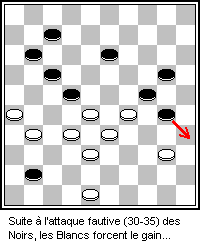Checkers
Checkers, also known as draughts in British English, is a board game played between two people on an 8×8 squared board with 12 pieces per player. The game is played on the dark squares of the board. The objective of the game is to capture all of the opponent's pieces or block them so they cannot move.
History[edit | edit source]
The history of checkers can be traced back to the ancient Egyptian civilization, around 3000 B.C. It is one of the oldest games known to man, with variations of it being played by numerous civilizations throughout history. The game evolved over centuries, with the 12-piece version on an 8×8 board becoming standard in the 16th century.
Gameplay[edit | edit source]
Each player begins with 12 colored discs (commonly black and white) placed on the three rows closest to them. The board consists of 64 squares, alternating between dark and light colors. The basic move of checkers is to move a piece diagonally forward to an adjacent unoccupied dark square. If an opponent's piece is adjacent to a piece and the square immediately beyond it is vacant, the piece must be captured by jumping over it. If a piece reaches the furthest row from the player, it becomes a king, marked by placing another piece on top of it, and gains the ability to move and capture both forward and backward.
Rules[edit | edit source]
The game is played on the dark squares only, and pieces can only move diagonally. Single pieces are limited to forward moves toward the opponent. When a piece is captured, it is removed from the board. A player wins by capturing all of the opponent's pieces or putting them into a position where they cannot move. A draw can occur if neither player can force a win, or by mutual agreement.
Variants[edit | edit source]
There are many variants of checkers, including:
- International draughts: Played on a 10×10 board with 20 pieces per player.
- Brazilian draughts: Similar to international draughts but played on an 8×8 board.
- Russian draughts: Also played on an 8×8 board, but pieces can become kings only if they end their turn in the promotion row.
- Canadian draughts: Played on a 12×12 board with 30 pieces per player.
Strategy[edit | edit source]
Checkers involves deep strategy, including positioning, sacrificing pieces for positional advantage, and planning ahead for multiple moves. Advanced players also use tactics such as the fork, where a single piece makes two or more threats simultaneously, and the pin, where an opponent's piece is rendered immobile.
Cultural Impact[edit | edit source]
Checkers has had a significant cultural impact, being featured in literature, art, and movies. It is seen as a game of strategy and intelligence, often used to teach problem-solving and strategic thinking skills.
Competitive Play[edit | edit source]
Checkers has a strong competitive play scene, with national and international championships. The World Checkers/Draughts Championship has been contested since the late 19th century. There are also numerous clubs and online platforms where enthusiasts can play and discuss strategies.
Search WikiMD
Ad.Tired of being Overweight? Try W8MD's physician weight loss program.
Semaglutide (Ozempic / Wegovy and Tirzepatide (Mounjaro / Zepbound) available.
Advertise on WikiMD
|
WikiMD's Wellness Encyclopedia |
| Let Food Be Thy Medicine Medicine Thy Food - Hippocrates |
Translate this page: - East Asian
中文,
日本,
한국어,
South Asian
हिन्दी,
தமிழ்,
తెలుగు,
Urdu,
ಕನ್ನಡ,
Southeast Asian
Indonesian,
Vietnamese,
Thai,
မြန်မာဘာသာ,
বাংলা
European
español,
Deutsch,
français,
Greek,
português do Brasil,
polski,
română,
русский,
Nederlands,
norsk,
svenska,
suomi,
Italian
Middle Eastern & African
عربى,
Turkish,
Persian,
Hebrew,
Afrikaans,
isiZulu,
Kiswahili,
Other
Bulgarian,
Hungarian,
Czech,
Swedish,
മലയാളം,
मराठी,
ਪੰਜਾਬੀ,
ગુજરાતી,
Portuguese,
Ukrainian
Medical Disclaimer: WikiMD is not a substitute for professional medical advice. The information on WikiMD is provided as an information resource only, may be incorrect, outdated or misleading, and is not to be used or relied on for any diagnostic or treatment purposes. Please consult your health care provider before making any healthcare decisions or for guidance about a specific medical condition. WikiMD expressly disclaims responsibility, and shall have no liability, for any damages, loss, injury, or liability whatsoever suffered as a result of your reliance on the information contained in this site. By visiting this site you agree to the foregoing terms and conditions, which may from time to time be changed or supplemented by WikiMD. If you do not agree to the foregoing terms and conditions, you should not enter or use this site. See full disclaimer.
Credits:Most images are courtesy of Wikimedia commons, and templates, categories Wikipedia, licensed under CC BY SA or similar.
Contributors: Prab R. Tumpati, MD





